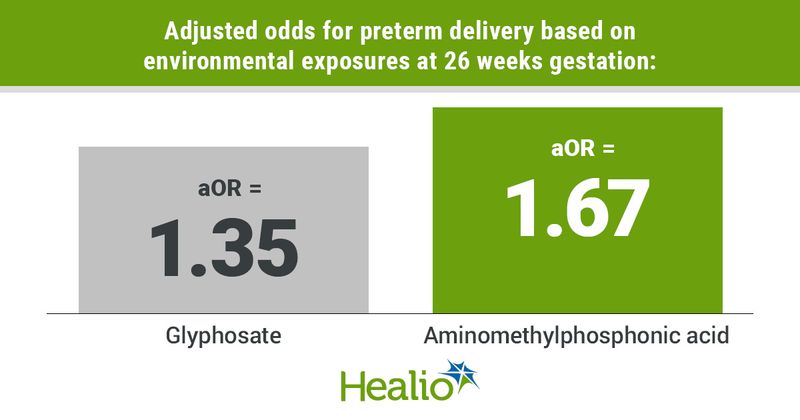Glyphosate exposure may increase risk for preterm birth
Click Here to Manage Email Alerts
Prenatal exposure to glyphosate, one of the most widely used herbicides in the world, was associated with an increased odds for preterm birth, according to researchers.
“Given the widespread use of [glyphosate], mounting concerns from the toxicological literature, the methodological limitations of the currently available epidemiological literature, as well as a dearth of information about the potential health effects of [aminomethylphosphonic acid], further investigation of potential adverse pregnancy outcomes following prenatal [glyphosate] and [aminomethylphosphonic acid] exposure is warranted,” Monica K. Silver, PhD, MPH, CPH, a postdoctoral research fellow at the University of Michigan School of Public Health, and colleagues wrote in Environmental Health Perspectives.

Silver and colleagues conducted a nested case-control analysis using data from the PROTECT cohort. The study enrolled pregnant women aged 18 to 40 years who lived in Puerto Rico, where rates of preterm birth are “particularly high,” even for the U.S., which “has some of the highest rates of [preterm birth] in the developed world,” according to the researchers. They collected urine samples around 18 weeks and 26 weeks gestation and measured levels of glyphosate and aminomethylphosphonic acid, which they wrote is “a highly persistent environmental degradate” of glyphosate, for 53 cases and 194 randomly selected controls.
In controls, glyphosate detection rates were 77.4% at 18 weeks gestation and 77.5% at 26 weeks gestation, and aminomethylphosphonic acid detection rates were 52.8% at 18 weeks gestation and 47.7% at 26 weeks gestation. According to the researchers, geometric means were 0.44 g/L at 18 weeks gestation and 0.41 g/L at 26 weeks gestation for glyphosate, and 0.25 g/L at 18 weeks gestation and 0.2 g/L at 26 weeks gestation for aminomethylphosphonic acid.
The adjusted ORs for preterm delivery based on exposure at 26 weeks gestation were 1.35 (95% CI, 0.99-1.83) for glyphosate and 1.67 (95% CI, 1.26-2.2) for aminomethylphosphonic acid, according to the researchers.
“This study provides evidence for associations between urinary concentrations of [glyphosate] and its environmental degradate, [aminomethylphosphonic acid], measured around the 26th week of pregnancy, and increased odds” for preterm birth, the researchers wrote.
In an invited commentary, Manolis Kogevinas, MD, PhD, a senior researcher and scientific director at ISGlobal, wrote that more research with larger cohorts is needed.
“The study is important, and the findings indicate potential reproductive health effects of low-level glyphosate exposures in the general population that are relevant globally,” Kogevinas wrote. “However, it certainly is far from conclusive.”
Kogevinas added that “apart from classical cohort epidemiologic studies, we now also need transdisciplinary research and action applying planetary health approaches to capture and eventually prevent the broader health effects of pesticides.”
References:
- Kogevinas M. Environ Health Perspec. 2021;doi:10.1289/EHP9428.
- Silver MK, et al. Environ Health Perspec. 2021;doi:10.1289/EHP7295.

